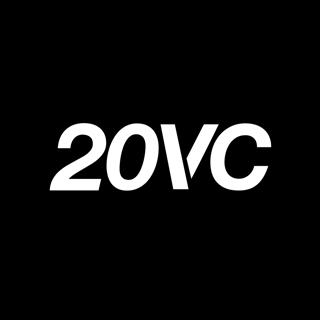
20VC: Monzo: The Greatest Turnaround in Tech: From £40M Revenues, Layoffs, Downrounds and Low Employee NPS to $1BN in Revenue, Profitable and 10M Customers with TS Anil, CEO @ Monzo
TS Anil is the CEO @ Monzo, where he has been the mastermind behind the greatest turnaround in tech in the last 10 years. When TS took over at Monzo they had £40M in revenue, very little runway, had a 40% down round and had large layoffs and low employee NPS. Today they are at £1BN in revenue, profitable and the UK's largest digital bank with more than 10m customers. From $40M Revenues to $1BN Revenues and Profitable: 1. What are the most profitable elements of Monzo's business today? How will that change in time? 2. What did TS do with Monzo that he wishes he had not done? What did he not do that he wishes he had done? 3. How does TS approach expansion? How will he win Europe against the competition of Revolut? 4. Why have no European fintechs won when expanding into the US? What do they do wrong? 5. How does TS think about the decision to go public? Will he go public in London? 6. How does TS respond to the notion that Monzo has a "work life balance" culture in the face of the fierce culture of Revolut? 7. What have been TS' biggest lessons from raising $1BN for Monzo from the largest institutions in the world? What was the easiest round? What was the hardest? 8. What three core traits does TS believe all great leaders need to have? If you do not have them, how can you develop them most efficiently?
13 Helmi 56min

20VC: The $5BN Company Built from the Belgian Countryside | The Story of Odoo: The Company with No Plans to Sell, IPO & Their Billionaire Founder Who Does Not Care About Money with Fabien Pinckaers, Founder & CEO @ Odoo
Fabien Pinckaers is the Founder & CEO of Odoo, one of the most incredible businesses that you might not have heard of. Built from the countryside of Belgium, they do an astonishing $650M in ARR, they have over 5,000 employees and have over 50,000 companies as customers. Even better, Fabian openly does not ever want to sell the company, IPO, believes that titles in companies are total BS and most management is done completely wrong. In Today's Episode with Fabien We Discuss: 1. Everything You Know About Management is Wrong: Why is it BS to give people titles in a company? How does Odoo hire people after only one interview? Why does Odoo prefer to hire really young people under 30? Why does Fabien think it is the worst to build a team in Silicon Valley? 2. The Billionaire Who Does Not Care About Money: Why does Fabien literally not care about money and does not even own a house? Why does Fabien refuse to ever sell or IPO Odoo? How does Fabien plan to offer liquidity to investors if he never wants to sell or IPO? 3. Why Did Every VC Turn Down the $5BN Odoo: What are Fabien's biggest lessons from being rejected by every VC for Odoo? What did they not see that they should have seen? Why did Fabien always want the price of the company on every funding round to be as low as possible? How does Fabien advise founders on pitching VCs today, knowing all he knows? 4. Scaling to $650M in ARR: The Biggest Lessons: Why does Fabien believe the biggest mistake companies make is they lose focus? What did Fabien not do with Odoo that they should have done? What did Fabien do and invest in, that with the benefit of hindsight they should not have done? When did the business start to break with scale? What would Fabien have done differently knowing all he does know?
12 Helmi 1h 15min

20VC: Why Model Providers Will Kill Many Startups Moving into the Application Layer | Why Deepseek is not a Threat to OpenAI & Why OpenAI Beats Anthropic | Apps vs Models vs Infrastructure: Where is Value in AI with Sridhar Ramaswamy, Snowflake CEO
Sridhar Ramaswamy is the CEO @ Snowflake, the $60BN public company with $3.5BN in revenue growing 30% per year. Sridhar joined Snowflake following his company, Neeva, being acquired by them for $150M. Prior to founding Neeva, Ramaswamy spent 15 years at Google where he had an integral part in the growth of AdWords and Google's advertising business from $1.5 billion to over $100 billion. In Today's Episode We Discuss: 1. OpenAI vs Deepseek vs Anthropic: Why will OpenAI beat Deepseek? What does no one see with Deepseek that they should see? Why has OpenAI beaten Anthropic? What elements turn a model from a commodity into a sustaining product suite? Will model providers become application providers? Will OpenAI be the biggest killer of startups in the next 10 years? 2. Snowflake vs Nvidia & Databricks: To what extent is Sridhar concerned NVIDIA will move into the data layer and compete with Snowflake? How does Sridhar view the competition from Databricks? What have they done better than them? What have they done worse than them and lost on? Does being private hurt or help Databricks in their fight against Snowflake? If Sridhar could, would he take Snowflake private today? 3. Leadership, Parenting, Money: Do richer leaders make better leaders? How does being rich change the mindset of a leader? What are Sridhar's biggest lessons when it comes to parenting? What about the way that Sridhar was brought up, did he do deliberately differently with his kids?
10 Helmi 55min

20Product: Product Secrets Behind Uber and Opendoor | How AI Changes the Role of the PM & The Product Development Process | How to Hire the Best Product Teams & What No One Does That Everyone Should Do with Brian Tolkin
Brian Tolkin is the Head of Product @ Opendoor where he has spent the last 6 years and is responsible for product strategy and product and design teams. Before Opendoor, Brian spent an incredible 5 years at Uber through their wildest growth periods. In Today's Episode with Brian Tolkin: 03:53 Brian's Journey at Uber: Launching China Pool 05:07 Product Lessons from Uber's China Launch 08:22 The Role of a PM in a Pre vs. Post AI World 10:16 Product Development Process in an AI World 17:43 The Importance of Simplification in Product Management 19:21 OKRs and Prioritization in Product Management 23:12 The Importance of Feedback Loops in Product Development 23:38 Evaluating Product Changes: User Adaptation vs. Bad Decisions 25:00 Balancing Gut Instinct and Data in Product Leadership 25:38 The Role of Simplicity in Product Design 27:02 Consensus vs. Dictatorial Product Leadership 27:54 Hiring for the Best Product Teams 31:33 How to do Effective Sprint Management 38:39 Quickfire Round: Insights and Advice
7 Helmi 44min

20VC: Affirm Max Levchin on Why Grading Talent by Letter (A or B) is Total BS | How to Create a Culture of Post Mortems and Writing | Why You Should Only Study Failure Not Success & The Biggest Surprises Scaling to $18.7BN Market Cap
Max Levchin is one of the great founders and technologists of our time. As the Founder and CEO of Affirm, he has built am $18.7BN monster in the buy no pay later space. Prior to Affirm he was one of the original co-founders of PayPal. Max is also the co-founder and Chairman of Glow, a data-driven fertility company. Max is also an immensely successful angel investor with a portfolio including the likes of Yelp, Pinterest and Evernote. In Today's Episode We Discuss: 04:19 How to Hire the Best People in the World 05:05 How to Manage Extreme Personalities 08:18 Biggest Lessons on Trust and What Happens When Lost 12:05 Is Grading Talent A and B Players Total BS? 15:31 How to Think About Calculated vs Uncalculated Risk 27:18 How to Create a Culture of Post Mortems: Step by Step 32:08 Why Every Person Must Write and How to Create a Writing Culture 36:01 Leadership Lessons from Layoffs 38:38 Is Affirm Losing or Beating Klarna in the US? 47:03 Peter Thiel or Elon Musk: Who Would Max Rather Start a New Company With? 48:37 Quickfire Round
5 Helmi 1h 2min

20VC: Lime's CEO on Going from Losing $3 on Every $1 to $90M in EBITDA | How Lime Built the Global Leader in Micromobility When Competitors Went Bust | Losing 90% of Revenues in COVID and The Uber Deal That Saved the Company with Wayne Ting
Wayne Ting is CEO of Lime. The global leader in micromobility, the first to achieve a fully profitable year (2022). Last year, Lime did over $600M in gross bookings, $90M in EBITDA. Their 4-year top-line CAGR is 30%. Before joining Lime, Wayne spent four years at Uber in various roles, including Chief of Staff to CEO Dara Khosrowshahi, and General Manager of Uber's Northern California business. Wayne previously served as a Senior Policy Advisor on the White House's National Economic Council under President Obama. In Today's Episode with Wayne Ting We Discuss: Is Lime Really a Good Business: How did Wayne turn Lime from losing $3 on every $1 to $90M in EBITDA? What worked? What did not work? What did Lime do that he wishes they had not done? What did they not do that he wishes they had done? The Moments that Changed Everything: COVID: Lime lost 95% of their revenues overnight. What did Wayne and Lime do to save the business in such a short space of time? Uber Deal: How did the Uber deal led by Uber CEO, Dara, save Lime as a business? Battery Innovation: How did an innovation on the transportability of batteries and replacing them change the entire Lime business? The Dangers of VC Funding and Capital Efficiency: Why does Wayne believe that VC hype cycles are so damaging for companies and sectors? How did the heat around micromobility damage Lime? What did Wayne and Lime do to increase their capital efficiency so much? What worked? What did not? AMA with the CEO of Lime: What company did Lime not acquire that Wayne wishes they had? How did having a stroke change the way that Wayne leads? Which competitor does Wayne most respect and admire? What were his biggest lessons from working with Dara @ Uber?
30 Tammi 1h 6min

20VC: Deepseek Special: Is Deepseek a Weapon of the CCP | How Should OpenAI and the US Government Respond | Why $500BN for Stargate is Not Enough | The Future of Inference, NVIDIA and Foundation Models with Jonathan Ross @ Groq
Jonathan Ross is the Co-Founder and CEO of Groq, providing fast AI inference. Prior to founding Groq, Jonathan started Google's TPU effort where he designed and implemented the core elements of the original chip. Jonathan then joined Google X's Rapid Eval Team, the initial stage of the famed "Moonshots factory," where he devised and incubated new Bets (Units) for Alphabet. The 10 Most Important Questions on Deepseek: How did Deepseek innovate in a way that no other model provider has done? Do we believe that they only spent $6M to train R1? Should we doubt their claims on limited H100 usage? Is Josh Kushner right that this is a potential violation of US export laws? Is Deepseek an instrument used by the CCP to acquire US consumer data? How does Deepseek being open-source change the nature of this discussion? What should OpenAI do now? What should they not do? Does Deepseek hurt or help Meta who already have their open-source efforts with Lama? Will this market follow Satya Nadella's suggestion of Jevon's Paradox? How much more efficient will foundation models become? What does this mean for the $500BN Stargate project announced last week?
30 Tammi 55min

20Sales: Why Every Sales Rep Should Do Pipeline Generation & How to Teach Them | Verticalised Sales Playbooks: When and How | How the Best Sales Reps and Leaders Structure Their Time with Carlos Delatorre, CRO @ Harness
Carlos Delatorre is one of the legendary go-to-market leaders of the last 20 years. Today, Carlos is the Chief Revenue Officer (CRO) at Harness, where he oversees global sales and go-to-market (GTM) operations. Before Harness, Carlos was the CRO @ MongoDB and Navan. Carlos is also an investor with a portfolio including the likes of Modern Treasury and Starburst to name a few. In Today's Sales Masterclass We Discuss: 03:48 The Art and Science of Sales 04:42 How to Hire Sales Talent 06:26 How to Build a Sales Team 15:28 Why Every Sales Rep Should do Pipeline Generation 19:45 How the Best Reps to Pipeline Generation 21:34 Biggest challenges of Pipeline Generation 22:44 Pipeline Generation Success Stories 34:59 Sales Metrics and Conversion Rates 35:32 Customer Acquisition Strategies 37:17 Evaluating Sales Performance 39:14 Effective Sales Training 43:10 Pipeline Generation and Deal Reviews 45:05 Maintaining Sales Team Morale 46:20 Verticalized Sales Playbooks 48:37 Addressing SaaS Churn Rates 49:49 Discounting and Deal Slippage 52:02 Transitioning to CEO Role 54:15 Hiring Mistakes and Sales Rep Evolution 57:03 In-Person vs. Remote Sales Teams 57:55 Account Management Strategies 01:02:47 Creative Sales Tactics 01:04:12 Final Advice for Sales Leaders 01:04:46 Adapting Sales Strategies During Crisis
24 Tammi 1h 8min






















